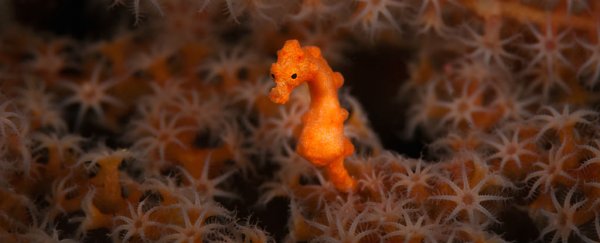For the first time, scientists have sequenced the entire genome of a seahorse to discover that it has a higher rate of evolution than any other species of bony fish that's been studied so far.
This rapid evolutionary rate explains many of the seahorse's strangest traits, including its toothless, tubular snout, unique body shape, and the fact that the male sea horse experiences pregnancy - not the female.
"We have discovered an array of changes in the genome, which helps to explain why the seahorse looks the way it does," one of the team, Byrappa Venkatesh, from the Agency for Science Technology and Research in Singapore, told PBS Newshour.
Venkatesh and his team sequenced the genome of the tiger tail seahorse (Hippocampus comes) - a threatened species from the tropical regions of the Western Central Pacific that can grow up to 18.7 cm long (7.4 inches).
Once they had the species' entire genome mapped out, they could start piecing together the evolutionary history that set seahorses apart from other teleost fish - a group that makes up 96 percent of all fish on Earth, including the most highly evolved ones.
If it hadn't really occurred to you that seahorses were a type of fish - just like catfish, salmon, and whatever's in your fish tank - that's kind of the point here.
Looking like a cross between a tiny pony and an eel, seahorses - and their close relatives, sea dragons and pipefish - don't look like any other type of fish on the planet.
And now scientists have pinpointed the genetic pathways that led to many of its unique features, such as a loss of teeth and pelvic fins, a poor sense of smell, and the ability for males to carry and birth their young.
One of the most obvious clues in the seahorse genome for how it ended up the way it is today is the fact that it's missing the P/Q-rich SCPP genes, which in other teleost fish are responsible for the production of enamel to form teeth.
The evolutionary pressures that would have come from a lack of teeth could explain how the seahorse's jaws ended up fusing into a long, tubular snout, which they use to suck up tiny morsels of food such as small fish and plankton, and swallow them whole.
Seahorses also lack pelvic fins - which gives them the appearance of a lovely proud chest - and the researchers found that they're missing the gene tbx4, which is a regulator of limb development in both fish and mammals alike.
"Given the major role of tbx4 in hindlimb formation in mammals, we hypothesised that its absence in H. comes might be associated with the loss of pelvic fins," the team explains.
To test this, they silenced the gene in the embryos of a regular-looking type of fish - zebrafish - to see what would happen.
"This resulted in mutant zebrafish that lacked the pelvic fins - demonstrating the expected effect of losing this very important gene," one of the team, Axel Meyer from the University of Konstanz in Germany, told Leigh Anne Tiffany at PBS.
The seahorse genome also shows a distinct lack of smell-related - or olfactory receptor - genes, which could explain why they depend more on their eyes to navigate through the ocean than their sense of smell and taste, like many other types of fish.
"We were able to identify in the H. comes genome a significantly smaller repertoire of olfactory receptor genes than in other teleosts," the team reports.
"[M]anual inspection identified only 26 olfactory receptor genes in the H. comes genome - the smallest olfactory receptor repertoire identified in any ray-finned fish genome analysed so far."
But in the midst of all these genetic deficiencies, seahorse genome revealed one very telling abundance: the patristacin gene. Not only is patristacin associated with male pregnancy, the seahorse genome contains six versions of it.
So how did the seahorse end up with so many changes in its genetic code, setting it apart from every other fish on Earth?
The team found that they had a higher rate of neutral mutations - genetic changes that are neither beneficial nor detrimental to survival - in their genetic history than all other teleost fish, suggesting that their DNA can change at a faster rate.
"Comparative genomic analysis identifies higher protein and nucleotide evolutionary rates in H. comes compared with other teleost fish genomes," they conclude.
"The reasons for this higher molecular evolutionary rate in H. comes are unclear."
The research has been published in Nature.
